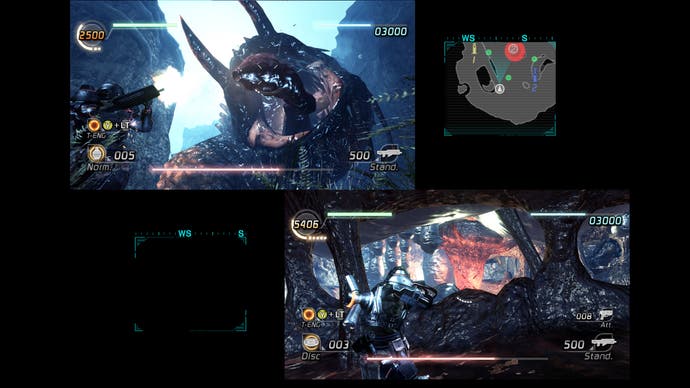Lost Planet 2
Gears of thaw.
One minute it's a mutated goat-faced crab bearing down upon your tiny band of soldiers, and the next you're valiantly facing off against a roaring stag beetle with a disturbing habit of flicking its prehensile tongue in your direction whenever you're down to the last sliver of health.
Of course, you're so pathetically ill-equipped to deal with these slithering, shrieking meanies by default that you may as well limply throw pebbles at them rather than fire your quite useless machinegun at their impenetrable hides - but this is where teamwork comes in. Rather than having to face all the enemy's attacks on your own, some members of the team can act as decoys while the others go off and dish out the pain.
The appearance of discarded gatling guns and rocket launchers offers a small amount of assistance, but the real saviours - as before - are the VS machines, the 'Vital Suit' mechs which afford you a much-needed degree of protection as you stomp around blasting orange weak spots with extreme prejudice.
Sometimes bosses' weaknesses are fairly obvious, but sometimes even exposing the orangey goodness requires a degree of hard work. Given how challenging the early bosses are, goodness only knows how fearsome they become as the game progresses.

According to Takeuchi, the one aspect of the game he's most proud of is the support system. "I think that this makes our four-player co-op a little bit different, because if you support your friends then you get points. We've got a support system where you can use support weapons like shields and healing items," he says. It's not an area we're able to test at this stage, but the implications of giving players an incentive to care for their team-mates ought to elevate it over many other co-op experiences where everyone's simply going for the glory.
As we touched on earlier, another element that has been radically overhauled is the game's aesthetic. It's set a decade after the events of the first instalment, and we return to E.D.N III to find that it's an altogether more hospitable place than when we left it. With terraforming efforts having been successful, some of the snow has melted away in various regions of the planet, revealing jungle, desert and even underwater regions, offering Capcom plenty of opportunity to show off the dazzling capabilities of its new MT-Framework 2.0 engine.
The astonishing detail level and deft array of beautiful effects leaves you in no doubt about the technical strides Capcom has made from the opening moments. This is the sort of game that will leave Digital Foundry lying awake at night (at least until the disc arrives in the lair - soon, pretties).
Wading through a lush jungle, the dense forest canopy creates a palpable sense of claustrophobic oppression in a way that simply hasn't come across in a videogame before. Close examination reveals an uncompromising, almost slavish attention to detail. Every branch and every leaf is superbly rendered, and each and every scene comes alive with stunning lighting and shader effects. Seeing this alongside a game like God of War III, it finally feels like the promise of this generation's technology is being realised.








